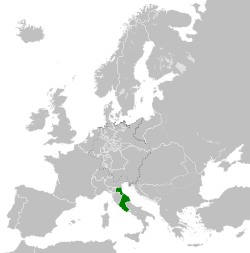State of the Church
| State of the Church | |||||
|
Stato della Chiesa Status Ecclesiasticus |
|||||
|
|||||
Anthem
|
|||||
|
The Papal States in 1815 after the Napoleonic Wars
|
|||||
|
Map of the Papal States (green) in 1700, including its exclaves of Benevento and Pontecorvo in Southern Italy, and the Comtat Venaissin and Avignon in Southern France.
|
|||||
| Capital | Rome | ||||
| Languages | Latin, Italian, Occitan | ||||
| Religion | Roman Catholic | ||||
| Government | Theocratic absolute elective monarchy | ||||
| Pope | |||||
| • | 754–757 | Stephen II (first) | |||
| • | 1846–1870 | Pius IX (last) | |||
| Cardinal Secretary of State | |||||
| • | 1551–1555 | Girolamo Dandini (first) | |||
| • | 1848–1870 | Giacomo Antonelli (last) | |||
| Prime Minister | |||||
| • | 1848 | Gabriele Ferretti (first) | |||
| • | 1848 | Giuseppe Galletti (last) | |||
| History | |||||
| • | Establishment | 754 | |||
| • | Codification | 781 | |||
| • | Treaty of Venice (independence from the Holy Roman Empire) | 1177 | |||
| • | 1st disestablishment | February 15, 1798 | |||
| • | Schönbrunn Palace Declarations | May 17, 1809 | |||
| • | 2nd disestablishment | September 20, 1870 | |||
| • | Vatican City | February 11, 1929 | |||
| Population | |||||
| • | 1853 est. | 3,124,668 | |||
| Currency |
|
||||
| Today part of | |||||
The Papal States, officially the State of the Church (Italian: Stato della Chiesa, Italian pronunciation: [ˈstato ˈdella ˈkjɛza]; Latin: Status Ecclesiasticus; also Dicio Pontificia), were a series of territories in the Italian Peninsula under the direct sovereign rule of the Pope, from the 8th century until 1870. They were among the major states of Italy from roughly the 8th century until the Italian Peninsula was unified in 1861 by the Kingdom of Piedmont-Sardinia. At their zenith, they covered most of the modern Italian regions of Lazio (which includes Rome), Marche, Umbria and Romagna, and portions of Emilia. These holdings were considered to be a manifestation of the temporal power of the pope, as opposed to his ecclesiastical primacy.
By 1861, much of the Papal States' territory had been conquered by the Kingdom of Italy. Only Lazio, including Rome, remained under the Pope's temporal control. In 1870, the Pope lost Lazio and Rome and had no physical territory at all, except the Vatican. Italian Fascist leader Benito Mussolini ended the crisis between unified Italy and the Holy See by signing the Lateran Treaty in 1929, thus recognizing the sovereignty of the Holy See over Vatican City.
...
Wikipedia




